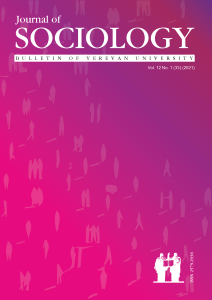Ideological Foundations and Cultural Manifestations of Youth Volunteering in Armenia
DOI:
https://doi.org/10.46991/BYSU:F/2021.12.1.020Keywords:
Ideology, Culture, Youth, Volunteering, Value-rational Action, Rationally-purposeful Action, Narrative SemioticsAbstract
The purpose of this study is to identify the ideological and cultural aspects of youth volunteering ․ The concept of social action by M. Weber and the functional model of volunteering were compared ․ Based on the developed conceptual approach, at the first stage of the study, using online surveys, the most common types of young volunteers in Armenia (goal-rational, value-rational and hybrid) were identified. High-quality interviews were conducted with representatives of each type using the methodology of narrative semiotics, revealing the life experience of Armenian volunteers. Narratives were analyzed using the method of narrative semiotic analysis. The article examines the peculiarities of the formation of civil society and the formation of civic consciousness of Armenian youth, it is shown that the ideological foundations and cultural manifestations of their volunteer activities are rational in nature.
References
Wilson, J. & Musick M. A. (1997). Who Cares? Toward an Integrated Theory of Vol-unteer Work, American Sociological Review, Vol. 62, No. 5, 694-713
Wilson, J. (2000). Volunteering, Annual Review of Sociology, 26. Doi: https://doi.org/10.1146/annurev.soc.26.1.215
Wilson, J. & Musick M. A. (2008). Volunteers. A Social Profile, Indiana University Press, 217-399
Hustinx, L., Cnaan, R. A. & Handy, F. (2010). Navigating Theories of Volunteering: A Hybrid Map for a Complex Phenomenon, Journal for the Theory of Social Behaviour, 414-418. Doi: https://doi.org/10.1111/j.1468-5914.2010.00439.x
Strauß, S. (2008). Volunteering and Social Inclusion, 1st Edition, Edited by Prof. Dr. Steffen Hillmert, University of Tübingen, Germany. Doi: https://doi.org/10.1111/0022-4537.t01-1-00027
Piliavin, J. A., Grube J. A. & Callero P. L. (2002). Role as Resource for Action in Public Service, Journal of Social Issues, Vol. 58, No. 3, 469-485
Salamon, L․ M., Sokolowski, S. W․ & List, R. (2003). Global Civil Society: An Overview, John Hopkins Comparative Nonprofit Sector Project
Juknevičius, S. & Savicka A. (2003). From restitution to innovation: Volunteering in post-communist countries, in P. Dekker and L. Halman (eds) The values of volunteering: Cross-cultural perspectives, New York, NY: Springer, 127–142. Doi: https://doi.org/10.1007/978-1-4615-0145-9_8
Howard, M.M. (2003). The weakness of civil society in post-communist Europe, Cambridge: Cambridge University Press. Doi: https://doi.org/10.1017/CBO9780511840012
Gevorgyan, V․ & Galstyan M. (2016) Why Volunteer? Understanding Armenia’s Experience Voluntary Sector Review. Vol.7. Number 3. Doi: https://doi.org/10.1332/204080516X14722016138748
Paturyan, Y. & Gevorgyan V. (2017). Volunteering in Armenia: Leaving the Soviet Legacy Behind? in Butcher J. & Einolf Ch. J. (Ed.) Perspectives on Volunteering: Voices from the South: Springer, 227-244. Doi: https://doi.org/10.1007/978-3-319-39899-0_12
Paturyan Y. & Gevorgyan V. (2014). Trust towards NGOs and volunteering in South Caucasus: civil society moving away from post-communism? Southeast European and Black Sea Studies, 14:2, 239-262. Doi: https://doi.org/10.1080/14683857.2014.904544
Wright, E.O. (2002). Sociology 298, Lecture 11: Class Analysis of Ideology, Retrieved from https://www.ssc.wisc.edu/~wright/SOC621/298lec11.pdf
Weber, M. (1956). The Nature of Social Action, Economy and Society 4th edn, Tubingen, First published in 1922
Hustinx, L., Cnaan, R. A. & Handy, F. (2010). Navigating Theories of Volunteering: A Hybrid Map for a Complex Phenomenon, Journal for the Theory of Social Behaviour, 413. Doi: https://doi.org/10.1111/j.1468-5914.2010.00439.x
Clary, E. G., Snyder, M. & Stukas, A. A. (1996). Volunteers’ Motivations: Findings from a National Survey Nonprofit and Voluntary Sector Quarterly, 485-505. Doi: https://doi.org/10.1177/0899764096254006
Clary, E. G., Snyder, M., Ridge, R. D., Copeland, J., Stukas, A. A., Haugen, J. & Miene, P. (1998). Understanding and Assessing the Motivations of Volunteers: A Functional Approach. Doi: https://doi.org/10.1037/0022-3514.74.6.1516
Clary, E. G. & Snyder, M. (1999). The Motivations to Volunteer: Theoretical and Practical Considerations, Current Directions in Psychological Science, Vol. 8, No. 5, 156-159. Doi: https://doi.org/10.1111/1467-8721.00037
Greimas, A. J. (1987). On Meaning: Selected Writings in Semiotic Theory, Theory and History of Literature, Volume 38, University of Minnesota Press, Minneapolis
Greimas, A.J. (2004). Strukturnaya semantika. Poisk metoda. Moscow. Akademicheskii proekt. 25-42
Titscher, S., Meyer, M., Wodak, R. & Vetter, E. (2000). Methods of Text and Discourse Analysis, Sage, 126
Fiol, M. C. (1989). A Semiotic Analysis of Corporate Language: Organizational boundaries and Joint Venturing, Administrative Science Quarterly, Vol. 34, No 2, 277-303. Doi: https://doi.org/10.2307/2989899
Wilson, J. & Musick, M. A. (2008). Volunteers. A Social Profile, Indiana University Press, 65
Downloads
Published
How to Cite
Issue
Section
License
Copyright (c) 2021 Harutyun Vermishyan, Tatyana Darbinyan

This work is licensed under a Creative Commons Attribution-NonCommercial 4.0 International License.








